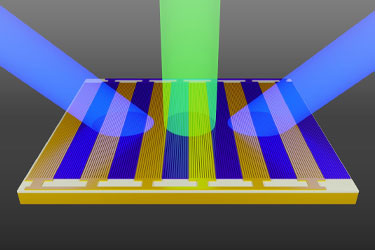Space-Time Metasurfaces: Unlocking a New Future for Wireless Communications and Optical Applications
Innovative breakthroughs in “space-time metasurfaces”
A team of researchers at the California Institute of Technology (Caltech) has delivered an impressive result by constructing a unique metasurface. This metasurface is covered with miniature, tunable antennas that enable the magical processing of an incident beam of light: when a beam of light enters, multiple beams exit, each with a different frequency and propagating in a different direction.
This innovative approach is very different from the traditional way of processing fiber-optic signals, which focuses on processing free-space signals, and enables the creation of numerous sidebands or channels of different light frequencies, opening up entirely new possibilities in the fields of communications and optics.
Potential Applications and Great Impact
In today's communication environment, when many people share a Wi-Fi network at the same time, they often experience network latency or lag. However, if everyone could have a dedicated wireless communication channel, communication speeds could be hundreds of times faster and bandwidth could be hundreds of times higher than existing Wi-Fi. This new research not only holds promise for the development of new wireless communication channels, it even opens up new ways of developing new ranging techniques and transmitting large amounts of data into space.

Principle of operation and properties of the space-time metasurface
When designing the metasurface, the research team had the ambition to go beyond what could be achieved with conventional optics, such as camera or microscope lenses. The multilayered, transistorized device, known as a spatiotemporal metasurface, is designed with a carefully selected pattern of nanoscale antennas that change the way light is responded to, reflecting, scattering, or controlling it in a variety of ways, such as reflecting it in a particular direction and at a particular frequency.
The core of the device is also quite compact, measuring 120 microns in width and length. When operating in reflection mode at optical frequencies, the wavelength of light used is 1530 nanometers, a frequency thousands of times higher than radio waves, meaning that the available bandwidth is significantly increased.
Future outlook and application vision
The team says that these metasurfaces may be able to play an important role in the future in the field of LIDAR, where light can be used to capture depth information in three-dimensional scenes. Their ultimate goal is to develop a “universal metasurface” that creates multiple optical channels in free space, each capable of efficiently transmitting information in different directions.
The team envisions a future in which many people using laptops in the same café no longer receive traditional wireless Wi-Fi signals, but instead receive their own high-fidelity beam signals and never have to worry about Internet speeds again.
MORE FROM WIRED

- Apple's fall event: iPhone 16 series makes a stunning debut

- Novel RNA Construction Module Enables Efficient Production of High-Density RNA Microarrays

- Innovative Applications of Drone Technology in Agriculture
- Aug,21,2024

- OpenAI Launches SearchGPT, an Innovative AI Search Engine
- Aug,19,2024

- Google Pixel 8A: AI technology-enhanced, the king of price-performance ratio
- Aug,07,2024

- Application of 5G in Intelligent Transportation System
- Aug,01,2024

- A New Process for Concrete Manufacturing: A Breakthrough in Efficient CO2 Sequestration and Quality Assurance
- Jul,25,2024